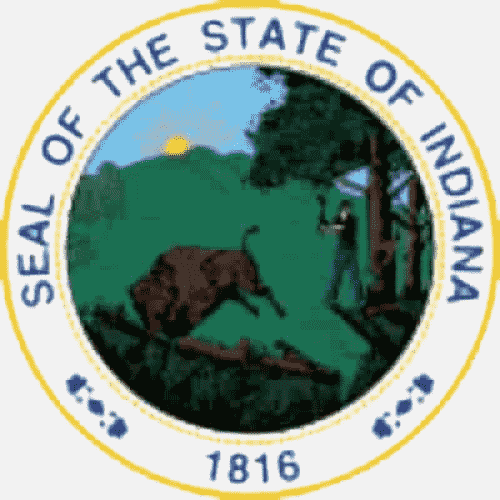 State Flag |  State Seal |
Indiana is a U.S. state located in the Midwestern and Great Lakes regions of North America. Indiana is one of eight states that make up the Great Lakes Region. Indiana is bordered on the north by Michigan, on the east by Ohio, and on the west by Illinois.
- ABBREVIATION: IN
- NICKNAME: The Hoosier State
- POPULATION: 6,924,275 (2024 est.)
- CAPITAL: Indianapolis
- STATE BIRD: Cardinal
- STATE FLOWER: Peony
- AREA: 36,418 sq. mi.
- TIME ZONE: Most of state Eastern (80 Counties), 12 Counties are Central
- ENTERED UNION: Dec. 11, 1816
- ALTITUDE: High, 1,257 ft. Hoosier Hill
- CLIMATE: Hot, humid summers, cold winters; moderate rainfall.
From the shores of Lake Michigan in the north to the curves of the Ohio River to the south, Indiana is a gentle land. The northern parts of the state were slow to bloom, for they lay off the westward route of the pioneers. Throughout its history Indiana was a battleground: Indians fought each other and fought the British; Indians and British fought French and Americans.
It was not until 1811 that Indiana’s territorial governor, William Henry Harrison, finally managed to put down the rebellious tribes at the battle of Tippecanoe, near what is now Lafayette. It was a useful victory not only for Harrison (in 1840 he won the Presidency for himself and running mate John Tyler with the slogan “Tippecanoe and Tyler too”) but for Indiana as well.
With the Indians pacified, farmers poured into the rich prairies. The railroads came in the 1840’s. In time, steel men took advantage of cheap transport routes and the state’s strategic location between iron and coal sources, and built the town of Gary on Lake Michigan. Today Indiana is the largest producer of steel in the United States.

Indiana Corn Field
Indiana remains essentially a quiet, rural state. Like many Midwestern states, Indiana has achieved an enviable economic balance. It produces heavy machinery, steel, and chemicals, yet 65% of its land is devoted to farmland, rich with corn, soybeans and oats.
Fun Facts:
- Indiana has more miles of interstate highway for each square mile of territory than any other state, and more major interstate highways intersect in Indiana than anywhere else in the country.
- Between 1900 and 1920, more than 200 different kinds of cars, including Duesenburgs, Auburns, Stutzes, and Maxwells, were manufactured in Indiana.
- During the great Depression of the 1930’s in southern Indiana unemployment was as high as 50 percent.
- John Chapman, better known as Johnny Appleseed, is buried in Archer Park in Fort Wayne. Every year Fort Wayne hosts the Johnny Appleseed Festival to commemorate the man who planted apple orchards from Pennsylvania to Illinois.
- In 1880 Wabash became the first city in the country to be lighted by electric lights.
- The first Raggedy Ann doll was created by Marcella Gruelle in Indianapolis in 1914.
History:
The history of Indiana is deeply rooted in the lives of Native peoples, frontier conflict, westward expansion, and industrial growth. Located in the Midwest, Indiana has played an important role in the broader American story, from early settlement to modern development.
Long before European settlers arrived, Indiana was home to several Native American cultures. The ancient Hopewell and Adena peoples built earthworks and burial mounds throughout the region. Later, tribes such as the Miami, Potawatomi, Shawnee, and Delaware lived in the area, relying on the land’s rivers, forests, and wildlife for survival.
These Indigenous communities developed vibrant cultures and extensive trade networks.
French explorers were the first Europeans to arrive in the 1670s, as part of the fur trade network extending from Canada. They built trading posts and missions, with Vincennes becoming one of the earliest European settlements in the state. After the French and Indian War (1754–1763), France ceded the territory to Britain, and after the American Revolution, it became part of the United States.
In 1787, Indiana was included in the Northwest Territory, and in 1800, the Indiana Territory was officially created with William Henry Harrison as its first governor. Harrison, who later became the 9th U.S. president, played a central role in the expansion of American settlement. Tensions with Native tribes escalated during this period, particularly as settlers encroached on Indigenous lands.
One of the most significant events of this time was the Battle of Tippecanoe in 1811. Harrison led U.S. forces against a confederation of Native tribes led by Shawnee leaders Tecumseh and his brother Tenskwatawa, also known as the Prophet.
Although the battle ended in an American victory, it intensified Native resistance and contributed to broader conflicts during the War of 1812.
Indiana achieved statehood on December 11, 1816, becoming the 19th state in the Union. The state’s early economy was based on agriculture, with settlers clearing forests to plant corn, wheat, and other crops. Over time, small towns and transportation networks developed, especially with the building of canals and railroads.
By the late 19th and early 20th centuries, Indiana transformed into an industrial powerhouse. Cities like Indianapolis, Fort Wayne, and Gary became centers of manufacturing, particularly for automobiles, steel, and farm equipment. The state’s central location made it a transportation hub, with major rail lines and highways passing through.
Indiana also played a role in social and political movements. During the Civil War, Indiana was a strong supporter of the Union, sending thousands of troops to fight. In the 20th century, the state experienced both progress and challenges, including labor strikes, civil rights struggles, and changing demographics due to immigration and urbanization.
Today, Indiana is known for its contributions to sports, agriculture, education, and manufacturing. It is home to the Indianapolis 500, major universities, and a strong cultural identity. Indiana’s history reflects a dynamic journey from Native lands and frontier battles to modern innovation and growth—shaping both the region and the nation.